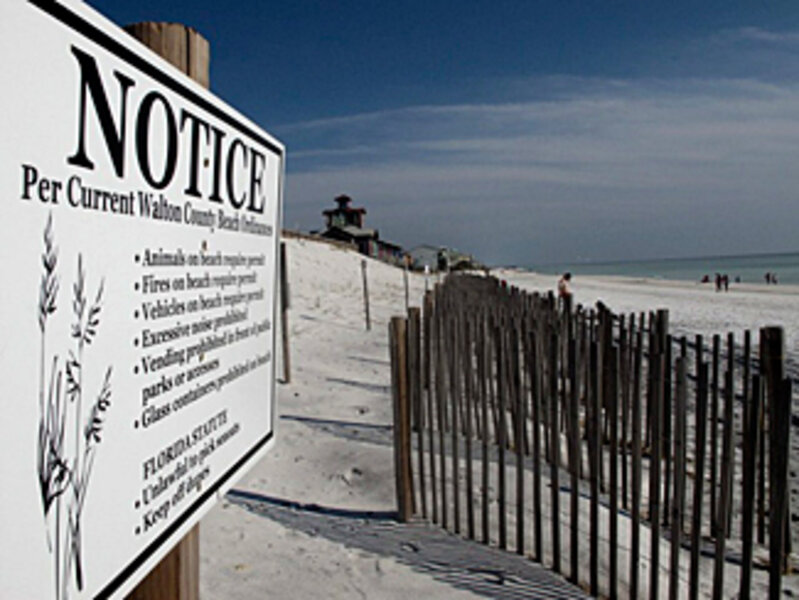Supreme Court case: Florida v. beach property owners
Loading...
| Washington
A group of beachfront property owners in Florida are set to argue on Wednesday at the US Supreme Court that Florida's highest court stripped them of their property rights and undercut the value of their land without paying any compensation.
The case marks the Supreme Court's first foray into the area of property rights since the justices handed down their controversial 2005 decision allowing the demolition of a New London, Conn., residential neighborhood to make way for a private development project.
The Florida case involves a dispute over whether Florida's Supreme Court violated the US Constitution when it ruled that the state did not have to pay compensation to beachfront landowners adjacent to a beach restoration project.
At issue in Stop the Beach Renourishment, Inc. v. Florida Department of Environmental Protection, is the scope and enforceability of littoral rights. Littoral rights are the rights enjoyed by the owner of private property fronting a lake, bay, or sea.
Traditionally, littoral rights in Florida included the right to own land up to the edge of the rising tide. This boundary is the place where the high tide meets dry sand. Lawyers and land surveyors call it the mean high water line (MHWL).
The problem with beachfront property is that beaches are constantly either eroding or accreting. As a result, the MHWL is always moving landward or seaward. That means beachfront land is always either shrinking or expanding.
Littoral rights include a risk that erosion might diminish waterfront property. But they also include a potential benefit – that any accretion would accrue to the owner.
Beach restoration project
The current case arose in 2003 when Florida officials proposed a beach nourishment program to pump new sand onto 6.9-miles of beach in and near the city of Destin in Florida's Panhandle region. State officials said the beach had been hit hard by a string of hurricanes and tropical storms.
Landowners disagreed. They said the beach had not eroded to critical levels.
Amid the dispute, Florida officials invoked the state Beach and Shore Preservation Act, which allows state officials under certain circumstances to change the boundary between submerged public lands and private waterfront property. Instead of using the MHWL as the property line, the state established a new boundary called the Erosion Control Line (ECL). Unlike the transitory MHWL, this is a fixed boundary based on beach measurements made immediately prior to pumping tons of new sand onto the beach.
Once the ECL is established, all sand pumped on the seaward side of the line comprises state-owned land under the Florida law. In the process, beachfront landowners lose their right to claim any accreted land seaward and their property is no longer in direct contact with the sea.
Complaints of demoting property
Lawyers for the landowners argue that by setting the new fixed boundary the state effectively demoted their clients' waterfront property into mere waterview property.
They took the issue to court. A Florida appeals court agreed with the property owners, ruling that the state had taken their property rights and reduced the value of their land without paying fair compensation.
On appeal, the Florida Supreme Court reversed. The court ruled 5-2 that since the state has an obligation to maintain Florida beaches "in trust for all the people," the designation of the ECL did not affect a taking of private property.
Beachfront property owners had no "vested right" to seaward accretions, the court ruled. The tradition that such accretions belonged to the upland owner was merely a "rule of convenience," and would not apply in the context of a state-run beach restoration project seeking to repair erosion from hurricanes, the Florida Supreme Court said.
The majority justices reasoned that the property owners still had an unobstructed view of the sea and unimpeded access to it. Besides, the new state-owned beach provided a buffer for adjacent private property against future storms.
"Over the years, about 198 miles of Florida's 825 miles of beaches have been restored under the [beach restoration act]," writes Florida Solicitor General Scott Makar in his brief to the court. "None of these [upland] property owners have claimed entitlement to money or title to the state-owned portions of restored beaches – until now."
State law precedents protect a property owner's access to the water but not direct contact with the sea, Mr. Makar said.
A states issue?
However, lawyers for the Stop the Beach Renourishment, Inc (STBR) land owners argue in their brief that physical contact with water is an essential feature of littoral rights.
"The Florida Supreme Court interpreted the [beach restoration law] to change the legal descriptions in the STBR's members' deeds converting waterfront property into water-view," writes Tallahassee lawyer D. Kent Safriet in his brief to the court. "The state now holds what STBR members once held: oceanfront property with all the attendant littoral property rights."
Mr. Safriet says the Florida high court's ruling brought about a "sudden and dramatic change of 100 years of state property law." He says it amounts to a judicial taking of property and that such a taking is unconstitutional unless the government pays fair compensation.
"This is not a case where a landowner's property is about to collapse into the ocean. If it were, landowners would likely waive any right to compensation in exchange for beach restoration," Safriet says.
Thomas Merrill, who represents Walton County and the City of Destin, warns the Supreme Court to avoid becoming entangled in a state law dispute. It should be left to the Florida courts to determine the substance of Florida property law, he says in his brief.
The US Supreme Court has never recognized a judicial taking claim, he says, adding that the Florida case does not support such a claim.
See also:
Public use, property rights and the courts
Last stand for property-rights activists
---
Follow us on Twitter.





